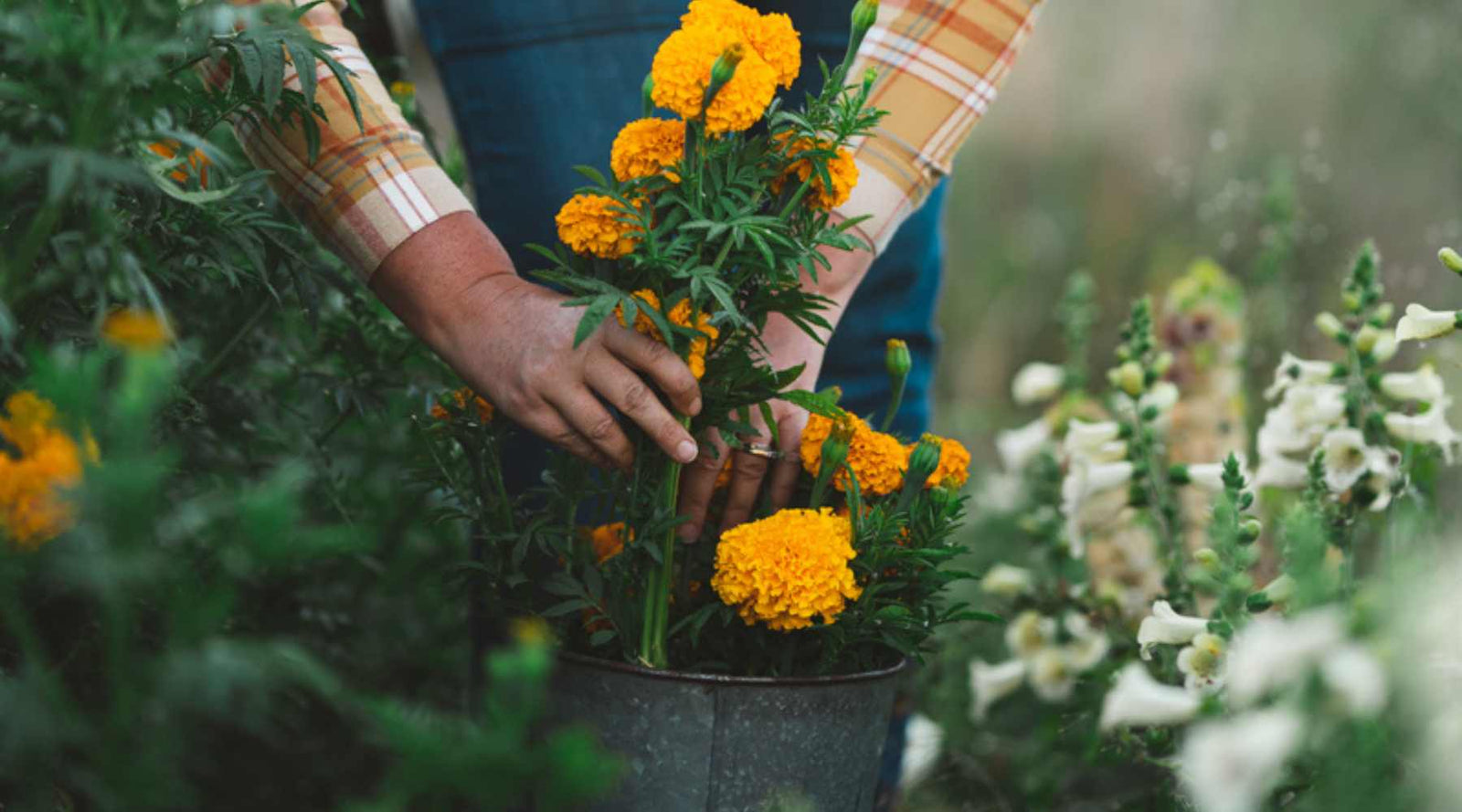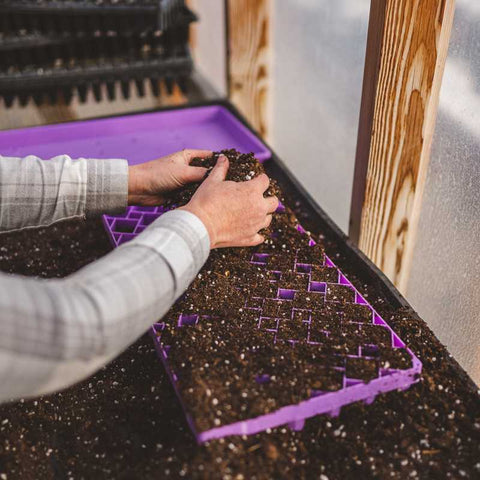Free Shipping on Orders over $75 to the Contiguous US
Free Shipping on Orders over $75 to the Contiguous US
Marigold Cultivation for Flower Farmers
June 27, 2024 9 min read 0 Comments

Today, we will talk about how to grow and use one of my personal fall favorites: marigolds.
What are Marigolds?
For avid gardeners, marigolds have earned their keep being planted by tomatoes and other crops for their ability to attract predatory insects while simultaneously repelling harmful nematodes and snails. Herbalists also utilize marigolds as natural dyes and even in the kitchen to add a pepper-citrusy taste to a dish.
Marigolds are ingrained in many cultures across the globe. Celebrations such as Dia de los Muertos (Day of the Dead) in Mexico, where marigold petals and full flowers are used to adorn alters that are made for their deceased loved ones to find their way back to them for the holiday. If their bright hues aren’t enough to help loved ones find their way, I bet the scent of the marigolds is! In the Hindu culture, marigolds are a vital flower not only in cuisine but in weddings and other festivals.
Marigolds are incredibly versatile flowers but have earned their keep in our cut flower field for being an outstanding cut flower.
I began growing marigolds because they brought back wonderful memories of visiting pumpkin patches in my childhood home town where they had giant fluffy marigolds standing amongst the corn. Marigolds perfectly encompass the colors of the fall leaves with their rich hues of yellows, oranges, and reds. As a flower farmer and florist, marigolds have become an essential crop for our late summer into fall designs thanks to their many uses and magnificent vase life.
There are three main marigolds we grow for cut flowers: African Marigolds (Tagetes erecta), French Marigolds (Tagetes patula) and Gem Marigolds (Tagetes tenuifolia). Each one provides a unique role in our floral designs.
Before getting into that, let’s go over how to grow these beauties successfully!
How to grow Marigolds

When Marigolds come into bloom
The days to maturity from seed sowing vary depending on the marigold variety. French marigolds are our first to come into bloom in about 50 days, closely followed by the gem marigolds in about 60 days, and lastly, our larger African Marigolds come into bloom anywhere from 75 to 95 days after planting.
Marigolds are incredibly cold-sensitive; they are in the top three of the most cold-sensitive crops we grow. Due to the pressure from our late spring frosts and early fall ones, we are typically looking to harvest marigolds from August through early October.
When to start and plant Marigolds
Marigolds can be started from seed either as a transplant, direct sown or propagated from a cutting. Marigolds are one of the easiest flowers to grow from seed. They germinate within a week’s time and grow fast. Timing is essential with marigolds, don’t let those six packs of marigold starts at the garden center fool you! Marigolds don’t like being root bound, which can stunt the plants' growth if left in starter pots too long. When growing them as cut flowers, we want to keep them happy and thriving to get the most and longest stems possible.

Growing Marigolds from Seed
Marigold seeds are little black-and-white slivers that almost remind me of tiny porcupine quills.
Keeping how quickly marigold seedlings grow in mind, you will want to start them four to six weeks before your lows begin to stabilize above 40 degrees Fahrenheit.
Marigolds love to be direct sown but since we have a relatively short frost-free growing season, we get a head start by preparing our first round of marigolds in the greenhouse. To account for their speedy and robust growth, we start marigolds in 72 or 50-cell seed planting trays. Additionally, we have had incredible success starting them in 2” soil blocks.
We prefer to two seeds per cell and then lightly cover with a dusting of vermiculite since light aids in the marigold’s seed germination. Marigolds should be grown on the warmer side at 75-80 degrees Fahrenheit for optimal germination. A heat mat and grow lights can aid during this process.
Our first succession is usually started in April and followed up with a direct sowing of them at planting time in May.

Propagating Marigolds from Cuttings
Marigolds root incredibly easily; in fact, we have had the cut flowers often root in the vase before the blooms fade!
Marigolds benefit from having their main stem “pinched” back when the plant is 8-12 inches tall. This is the process of removing the main stalk and usually two sets of true leaves. The removed stalk should be about four inches in length, which happens to be the perfect size for propagating, but more on that in just a second.
Marigolds can have fairly thick stalks even at this phase, I recommend using clean floral cutters. Taking the time to do this extra step will encourage the plant to branch out, producing more and longer stems.
As mentioned, after pinching the plant pack, you can take the waste part and root it to increase your volume of plants, especially the African varieties. Make sure to strip the leaves off the stem leaving one set of leaves and pinch out the node off the top. Dip the stems in your chosen rooting hormone and place in a prepared seed planting tray, making sure to leave only the top set of leaves.
We love using these clear 6-cell trays for cuttings so we can see the new root growth. If you want to grow bigger transplants from cuttings you can use a propagation kit with clear pots. Using clear pots saves you from possibly damaging your new plants by pulling on them to check for root growth.
Keep the tray watered properly; moist but not saturated. Place the tray on a heat mat set to 75 degrees Fahrenheit, out of direct sun, with a humidity dome lid.
Remember to check on cuttings and mist leaves with water each day. In the beginning, you may be misting the cuttings two to three times a day. To check if the cuttings have rooted in a regular black cell tray, give a gentle tug on the cutting; when the cutting gives resistance, it has rooted. Remove the dome lid at that time.

Succession Planting Marigolds
Marigolds can be succession sowed in intervals of four weeks for continuous blooms, we like to do one to two successions. If you have customers in your community who will want a lot of marigolds for particular holidays, you may do a third planting to have plenty available come late October or early November.
Planting and Maintenance
Marigolds need full sun, requiring a minimum of six hours per day. Marigolds like their soil well draining but with consistent watering through drip irrigation. However, they tolerate dryer soil once established better than some other crops.
Marigolds are one variety that you really want to heed the warning on the packet to “plant after all danger of frost has passed.” We plant our first succession in mid-May.
Since our area is prone to unexpected frosts, we do cover minimally with a micro tunnel of frost cloth but are also prepared to cover the marigolds with a double low tunnel to protect them better if the temperature dips below thirty-seven degrees Fahrenheit.
The different types of marigolds have different spacing recommendations anywhere from 8” to 18”. However, to maximize the output from our growing beds, we grow each of our marigold varieties with our most common spacing at 7”x7”. We grow in the arid high desert, If you grow in a more wet and humid climate, you may find that giving your plants more space may help to lessen disease pressure for you.
African marigolds greatly benefit from horizontal trellising since they can get quite top-heavy, which can result in broken stems or plants falling over.
Pests and Disease
Marigolds are vulnerable to powdery mildew, blights and rot (root, crown, and stem), leaf spot, verticillium wilt, aster yellow, and tomato spotted wilt virus.
Marigolds are great at attracting beneficial insects, unfortunately, though it can be a double-edged sword, as they also have a slew of pests that love them, such as earwigs, white flies, various caterpillars, leaf miners, spider mites, thrips, slugs, and aphids.

Harvesting Marigolds
Marigolds are some of the most forgiving crops when it comes to harvesting. Marigolds are ideally harvested in the afternoon, which is great when you’re running behind!
Marigolds are harvested open with tight centers but can be harvested when flowers are half open for long-term storage. Once their centers become too open, the flower easily shatters as it sets seed.
There is one thing to be aware of when harvesting marigolds, especially towards the end of the season, their necks break easily. I find this to be more frequent with the larger-headed African Marigolds. Sometimes, a single stem will have multiple heads; because of the marigold’s fragility, I often leave them as a spray. Another potential downside is marigolds are quite fragrant. Customers either love it or hate it. To lessen the intensity of the scent, strip as many leaves off as possible.
African marigolds have the longest stems out of all the varieties for us, averaging eighteen inches. When harvesting, I measure out from the crook of my elbow down to the tip of the clippers in hand, cutting to the plant's main stalk.
Marigolds benefit from being cut deep, to encourage new branching for subsequent harvests. Don’t be timid when harvesting.
Gem Marigolds can look like a tangled mess. Instead of harvesting individual stems, we cut at the base of the plant to take the entire spray. Harvest when flowers are halfway open; cutting too soon may result in wilting.
French marigolds do not typically produce long stems; we cut when the flower is fully open with a tight center, harvesting it down the base of the plant in a similar fashion as the gem marigolds.
We bundle marigolds in five-stem bunches to avoid potentially overcrowding and snapping necks. Once rubber banded we place them in a clean bucket of water treated with a preservative tablet. Marigolds can be placed into the cooler but also do well in a cool, dark room. Marigolds are one of the cultivars of cut flowers that can be dry stored for up to two weeks in the cooler, which decreases water-borne bacteria and increases vase life.
Marigolds have an average vase life of 7-10 days, though we have had customers report having them for upwards of three weeks—marigolds like the use of commercial flower food.

Marigolds for Floral Designs
Marigolds are a multifaceted design component where the enormous cushiony African marigolds can be used as focal flowers; the gem marigolds are lovely as a filler or to add some interest and space into a floral design or bouquet. Marigolds are often used as a disk design component to support other luxurious flowers in bloom, such as dahlias.
Marigolds are great at being out of water, making them popular in garlands, leis, and smaller flowers in boutonnieres or corsages.
Marigolds, being edible, make them an excellent flower for market growers focusing on vegetables to offer something unique and different to their CSA members or restaurant accounts. The gem marigolds are dainty and unique as a garnish for a salad or drink. Of all the types, they also taste the best. Other marigolds can be quite bitter.
Some Favorite Marigold Cut Flower Varieties
The more commonly known marigolds have bright, bold colors of yellow, orange, and red, which is fantastic for mixed bouquets or rustic mason jar designs. The crackerjack and narai varieties are popular ones to grow. For our flower farming business, we do many weddings for which those brighter colors aren’t always popular. We need varieties that are more muted and appropriate for event work. Over the years, we found varieties that work great for mixed bouquets and wedding work alike.
White swan is one of our favorite cream marigolds with flower sizes that aren’t too overbearing, making them perfect to pair with dahlias and wisps of ornamental grasses. We’ve tried other cream-colored marigolds in the past, and this variety provides the longest, most usable stems compared to the other ones we’ve tried.
Our go-to for a more traditional African Marigold is the Coco Gold. After years of trialing various African Marigolds, Coco Gold is the perfect orangey-bronze with large, thick flower heads atop solid stems. It is also a variety that seems to tolerate the light fall frosts we begin getting in September. A perfect variety to grow for those who want to offer marigolds, especially for Dia de los Muertos!
The star fire mix is our choice for the gem marigolds since it has a lovely blend of reds, lemony yellows, and golden oranges.
Lastly, strawberry blonde is the only French marigold we grow due to its unique honey-warm pink coloration. Though Strawberry Blonde is on the shorter side, I adore using it for bud vases, boutonnieres, and corsages in fall weddings.
Marigolds have a vast amount of different applications. With so many varieties to choose from, it is an excellent crop for a flower farmer to offer. Whether it is a cream-colored one tucked in with some lisianthus in a bridal bouquet or a mixed bouquet tucked next to pumpkins at the farmer’s market, it will surely delight!
Written by: Jessica Chase, Sierra Flower Farm, Photography by: Graham Chase, Sierra Flower Farm
Subscribe
Sign up to get the latest on sales, new releases and more …
